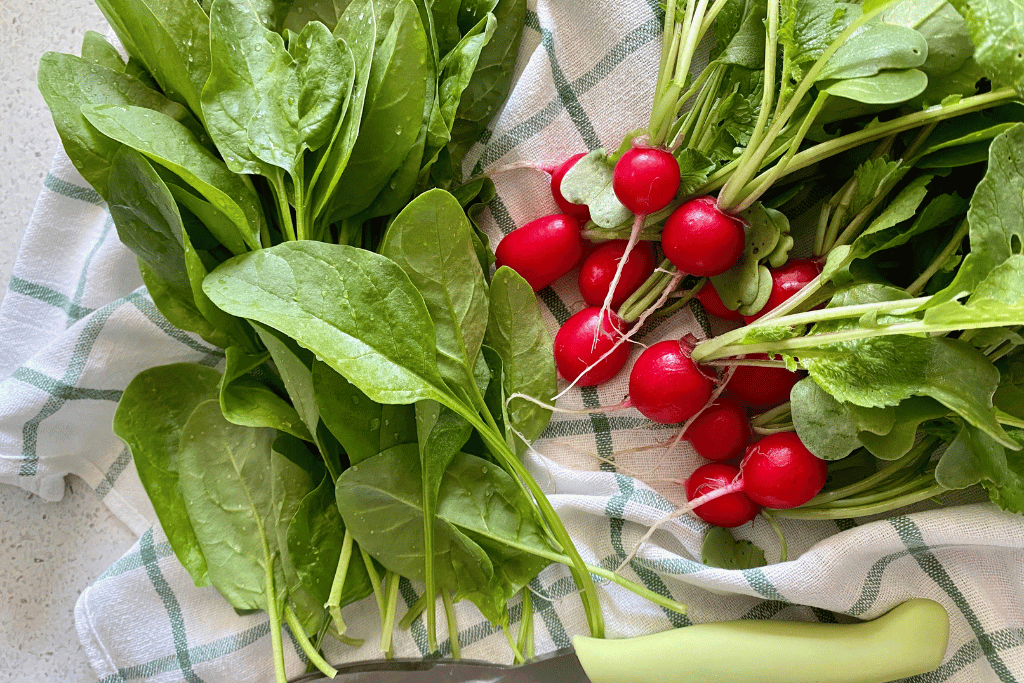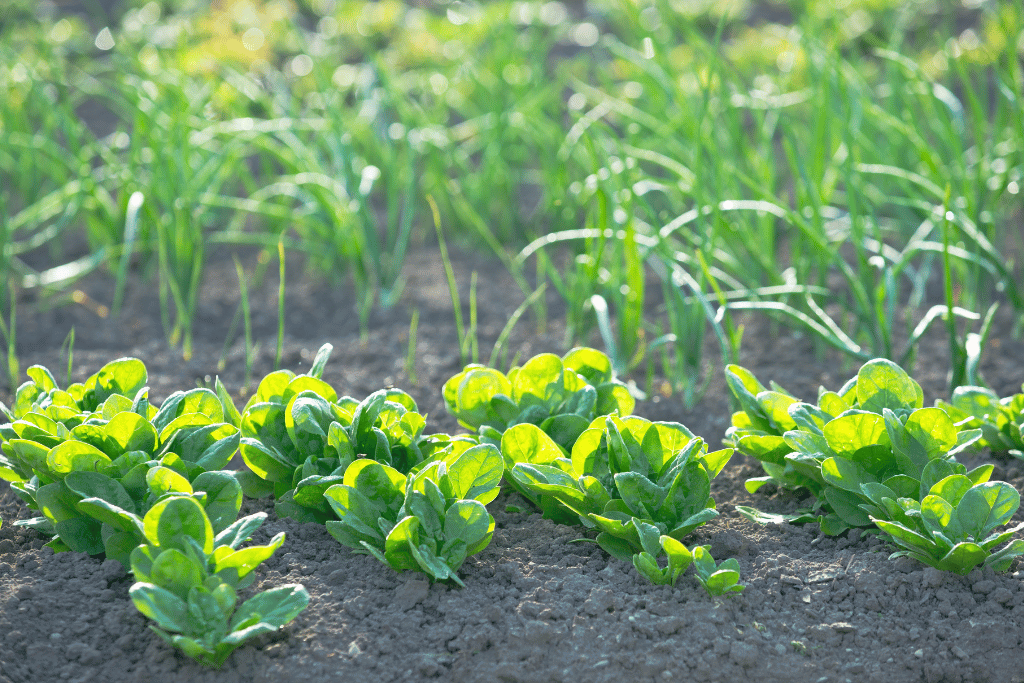
As a youngster, spinach was not appealing to me.
For whatever reason, it was always served up overcooked, limp, lukewarm and mushy.
Not exactly the appetizing performance-enhancing vegetable Popeye was always slugging down.
Flash forward to the future and my farming and gardening path revealed to me that spinach was actually a tender and tasty green when grown fresh. Planted in neat little rows, tufts of spinach grow prolifically, producing multiple harvests over the course of the year.
Impressed by its growing habit, fresh taste and superfood status, I have since accepted spinach back into my life.
It can be palatable after all when added fresh to a salad, blended into a smoothie, baked into a quiche or sauteed with garlic and onion. Anything but boiled mush from a can (what was my Mom thinking?)
With all of those exceptional combinations in the kitchen, you would assume that spinach also keeps plenty of good company in the garden.
And you would be right!
Read on to learn about all of the best companion plants to surround spinach in the garden.
Spinach as a Companion Plant
Spinach is a cool weather crop that grows from a central rosette, producing broad, green leaves on stems reaching up to 18 inches in height. It has shallow roots that are happiest in cool, loose and fertile soil.
In the world of companion planting, spinach may not receive a high rating from most of itsgarden vegetable peers. Spinach is of course a valuable and nutritious crop, but unlike other popular vegetables and herbs, is more of a receiver than a giver of companion benefits.
Without any natural defenses, spinach leaves and roots are often targeted by pests or damaged by the elements.
Like all of us, spinach gets by, and thrives, with a little help from its friends.
Brassica Vegetables
The plant genus that includes broccoli, cabbage, cauliflower, mustard, kale and kohlrabi makes great neighbors for spinach. It’s common to tuck rows of spinach in between rows of brassicas.
The roots of brassicas grow deep into the soil and don’t interfere or compete with spinach roots for water and nutrients. As the season progresses into the warmer summer months, vegetables like broccoli or kale will tower over the stout rows of spinach, providing some welcome shade for the leafy green. Planted closely together, spinach will receive shelter and you can save some space in the garden.
Radish
The tiny, red pungent root crop does a wonderful service when planted alongside rows of spinach.
Leaf miners and flea beetles will be drawn away from damaging the lush, green spinach leaves with radishes working as a trap crop in this scenario. The pests feed on radish greens, hopefully leaving your spinach alone. And radishes grow so quickly that their roots shouldn’t be affected by damaged leaves.

Alliums
The powerful, pungent stench of onions, chives, garlic and leeks drives away hordes of pests.
For this reason, they should be considered for every gardening space. Alliums are especially effective when grown in the vicinity of spinach. They will ward off beetles, aphids, rodents and even deer. Anything that might want to munch on your tender greens will be truly turned off by the offensive odor.
Beneficial insects like parasitic wasps and ladybugs just happen to be attracted to alliums. They’ll go to work eating common spinach pests, keeping your crop doubly protected.
Read the growing guide: Companion planting onions.

Nasturtium
Aphids are a common nuisance for spinach plantings, feasting on the soft, fresh foliage. The bright orange edible flowers of nasturtium are a key ally in this struggle.
Nasturtium has a strong smell that repels many pests, except for aphids. Aphids love nasturtium and will flock to it any chance they get. So, planting the dainty flower around your spinach crop will assuredly keep it safe from aphids. And nasturtium grows so prolifically, that once they’re established, you’ll certainly be able to enjoy their flowers as well.
Tomatoes
Planting spinach alongside tomatoes is a good lesson in timing and spacing in the garden.
Spinach will most likely be planted early in the spring, well before tomato seedlings are transplanted out. When weather permits, tomatoes can be planted alongside rows of spinach without any fear of interference. Your early season spinach crop will be harvested well before the tomato plants begin to take over the space with their dense green foliage and red fruits.
It’s a great way to maximize space in the garden and with just the right timing, the tomato plants will also help keep spinach shaded and cool.
Lettuce
Due to their similar growing styles, spinach and lettuce are perfect partners in the garden.
They can be interplanted closely together in alternating rows to create a complete groundcover. This not only saves lots of space in the garden, but will suppress weeds and help to retain moisture while keeping the soil cooler longer and protecting the shallow roots.
The two leafy green complementary crops even prevent eachother from bolting and going to seed too soon.

Strawberries
A funny sounding combination, spinach and strawberries actually work quite well together.
The roots of each plant feed at different soil levels and the running strawberry stolons and leaves provide excellent groundcover for spinach. Planted together, strawberries and spinach will also team up to deter common diseases of the garden.
Peas and Beans
Legumes are beneficial to the garden in many ways; plant some near your spinach to take advantage of their nourishing properties.
Spinach, being a leafy green vegetable, needs plenty of nitrogen to produce a strong stem and broad, nutritious leaves. Peas and beans take the nitrogen that’s in the air and fix it into a usable form for other plants in the garden. So planting a row of peas or beans would certainly improve spinach production and taste.
Peas and beans can also be used to shade your spinach during the hotter summer months, keeping the soil cool and preventing spinach from bolting.
Cosmos and Zinnias
Two flowers that will certainly support your spinach crop are cosmos and zinnias.
Cosmos towering height can help shade spinach from the summer sun while also inviting many predatory beneficial insects.
Zinnias will also help keep your spinach cool while repelling pests that are known to disturb the leafy green foliage.
What NOT to Plant With Your Spinach
Fennel is the classic example of what not to grow with any other plant, especially spinach. The chemicals that fennel releases into the soil impedes root growth. We already know that spinach roots are shallow and fragile to begin with, so don’t consider planting fennel anywhere near it.
Potatoes are another fantastic food to grow, but won’t do well when planted with spinach. Flea beetles are attracted to potato leaves, and an invasion of this pest could destroy your spinach crop. Potato plants consume tremendous amounts of nutrients and their foliage grows bushy and require the hilling of soil. All of this disruption would be too much for your spinach to handle.
Don’t Let Your Spinach Go Lonely
If you take anything form this article let it be that spinach, planted on its own, might not thrive how you’d like it to. It’s an easy target for pests and has vulnerable, shallow roots that don’t like to get too hot.
Utilize the advantages of companion planting and invite a bunch of friends into your spring and fall spinach patch. Performance, yield and overall garden health will thrive following the principles of proper companion planting.
Frequently Asked Questions (FAQ)
Does spinach need a lot of space to grow?
Spinach doesn’t require much room and can grow efficiently in compact spaces, which is why they pair well with many other crops. Space spinach plants 3-4 inches apart to harvest baby greens, or 6+ inches apart to grow mature plants.
When is the best time of year to plant spinach?
Spinach is a cool weather crop that thrives in early spring and late fall. Growing in the cool weather helps to minimize pest pressure and some say the leaves taste better after a touch of frost!
Can spinach be harvested more than once?
Yes! When cutting spinach just be sure to leave enough of the central rosette where the leaves grow. In a few days, you’ll notice it starting to regrow.
What herbs should be planted next to spinach?
Cilantro, dill, parsley and chives all aid a successful spinach crop.
What do I do when my spinach bolts?
At this point, the spinach plant can be pulled up and discarded, as the leaves become bitter, tough and inedible. Or leave it to go to seed for collecting.
Once spinach is out of the garden a warm season crop can be planted in its place.



